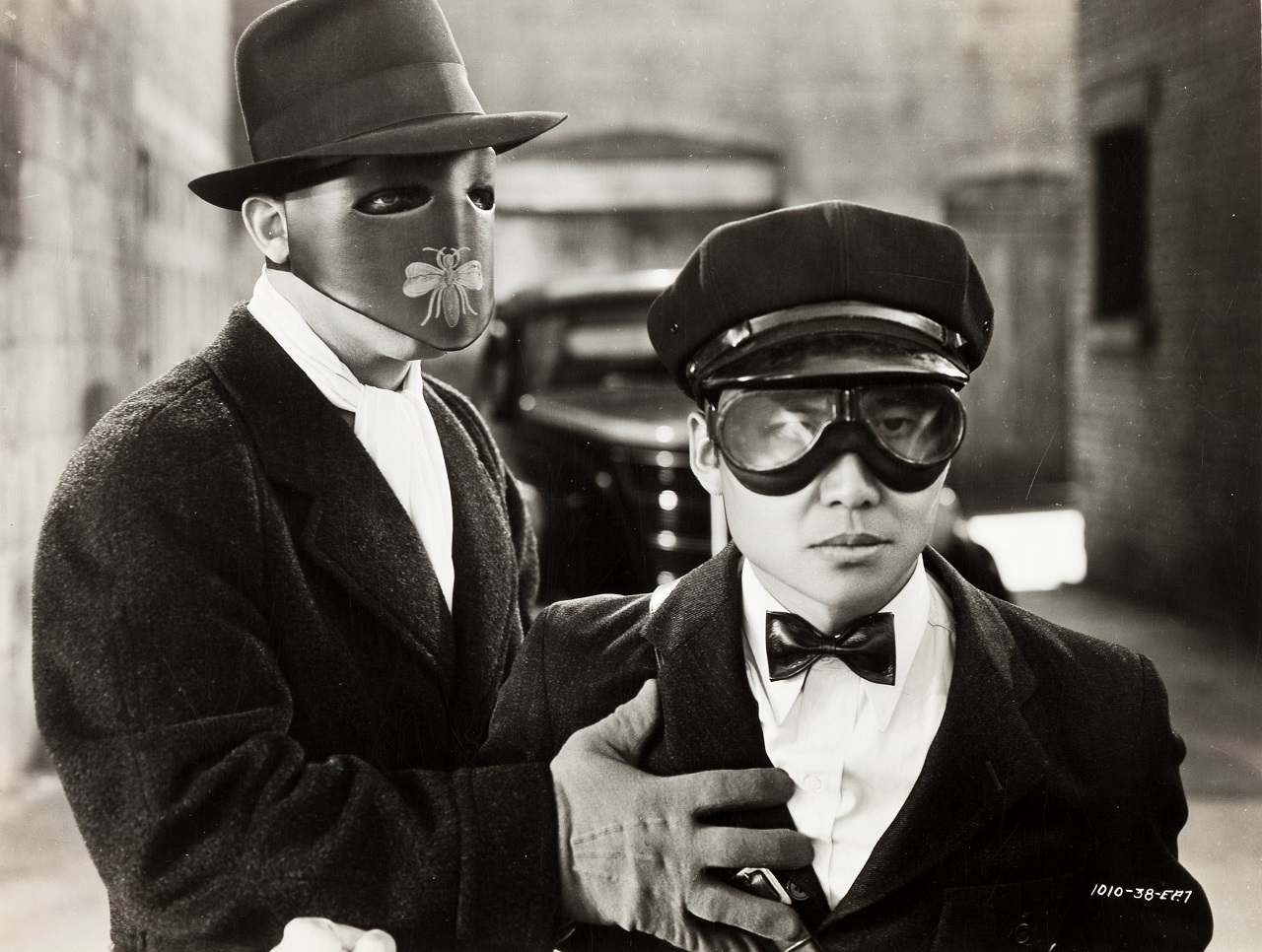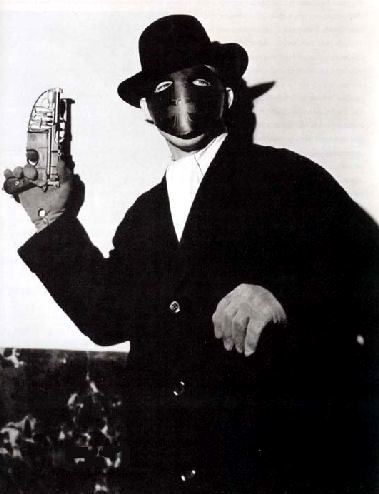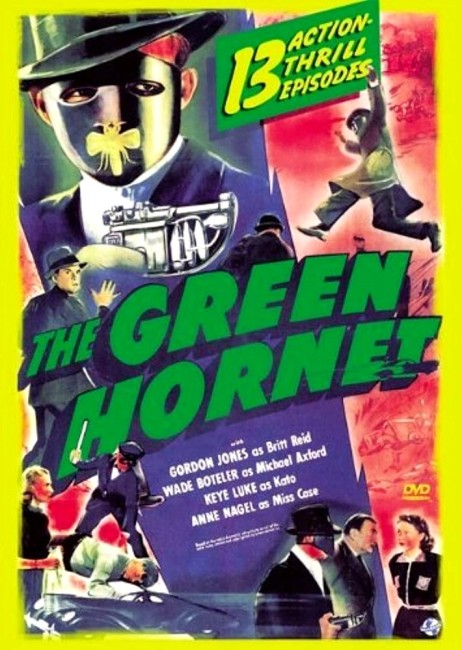USA. 1940.
Crew
Directors – Ford Beebe & Ray Taylor, Screenplay – Basil Dickey, Lyonel Margolies, George H. Plympton & Morrison C. Wood, Based on the Radio Series Created by Fran Striker, Photography (b&w) – Jerry Ash & William Sickner, Art Direction – Harold H. MacArthur. Production Company – Universal.
Cast
Gordon Jones (Britt Reid/The Green Hornet), Keye Luke (Kato), Wade Boteler (Michael Axford), Anne Nagel (Lenore Case), Phillip Trent (Jasper Jenks), Cy Kendall (Curtis Monroe), Stanley Andrews (Police Commissioner), Selmer Jackson (District Attorney George Scanlon), Joseph Crehan (Judge Stanton)
Plot
Britt Reid is the editor of the newspaper The Daily Sentinel, which he has inherited from his father. His secretary Lenore Case wishes there were a modern Robin Hood to take on the rampant racketeering in the city. Inspired by this, Britt dons a hat and mask to become The Green Hornet, armed with a gun of his own invention that fires gas pellets. Aided by his Korean manservant Kato, he heads out driving Black Beauty, a reconditioned roadster capable of high speeds, to put a stop to the racketeers.
The Green Hornet is a masked superhero who has appeared in a number of different media incarnations. The Hornet is the alter ego of playboy newspaper publisher Britt Reid who dons mask, fedora and overcoat to fight crime alongside his faithful Japanese (later Filipino and Korean) chauffeur Kato, The Green Hornet originally appeared as a radio series from Fran Striker, the co-creator of The Lone Ranger (in the radio series, one episode identifies The Hornet as the son of the Lone Ranger). The Green Hornet first appeared on WXYZ station in Detroit, originally broadcast live, and was then syndicated throughout the USA from 1938, lasting until 1952. For most of the run, the Hornet was voiced by Al Hodge, although other actors also took up the part.
The Green Hornet was first adapted to the screen with this serial and its sequel The Green Hornet Strikes Again (1940). The most popular incarnation of the character came with the subsequent tv series The Green Hornet (1966-7) starring Van Williams as Britt Reid/The Green Hornet and with a young unknown Bruce Lee as Kato. This was made by William Dozier, the creator of the hit Batman (1966-8) tv show – indeed, The Green Hornet and Kato crossed over to appear in a double-episode of Batman. Despite the tv series setting in place many aspects of the characters, it only lasted for one season of 26 episodes. These were later repacked as two feature films with The Green Hornet (1974) and Fury of the Dragon (1976) to take advantage of Bruce Lee’s subsequent stardom. The series was later revived in the film The Green Hornet (2011) from director Michel Gondry with a miscast Seth Rogen as Britt Reid and Jay Chou as Kato, but this opted for a comedy playing.
This version was a serial in thirteen weekly chapters. Serials were a form of film-making that has disappeared today. A serial would run to about 15-20 minutes in length and would appear before the matinee feature (usually along with a cartoon and maybe a newsreel). Each episode would end on a cliffhanger – the genre literally gave birth to the term – with the hero or heroine in some form of peril or thought killed, where audiences would have to wait to the following week to find out how they survived. The serials began in 1913 and found their greatest popularity during the 1930s and 40s. The last serial was produced in 1956, around the same time that commercial television started to become widespread.
A number of serials were adaptations of various Superheroes, which were just starting to appear on the comic-book page around this time. This period also saw a number of Comic Book Adaptations conducted as serials, beginning with the successful Flash Gordon (1936) and continuing through Dick Tracy (1937), Buck Rogers (1939), Mandrake, The Magician (1939), Adventures of Captain Marvel (1941), Batman (1943), The Phantom (1943), Captain America (1944) and Superman (1948).

The Green Hornet was the only superhero of the era not to be adapted from a comic-book. Some genre commentators have created a distinction between superheroes and Masked Heroes, which include the likes of The Lone Ranger, Batman and The Phantom – superheroes who have no extra-normal powers ie. their powers come from fighting skill and the gadgetry they wield. In the case of The Green Hornet, the most fantastical he ever gets here is the invention of a gun with a transparent front magazine that fires knockout gas pellets and a sleek looking two-seater speedster whose engine Kato has apparently souped up to run at high speeds (all accompanied by a hornet-like buzzing noise). The gadgetry in the 1960s tv series became far more science-fictional.
I can find little publicity material about the radio show. The question that intrigued me was how much of The Green Hornet mythos came from the radio show and how much was first put down in this serial. The characters of Britt Reid and his background as a playboy who has inherited a newspaper, his secretary Lenore Case and bodyguard Mike Axford are all taken direct from the radio incarnation. Kato makes his transition from Japanese to Korean here, it is claimed to avoid anti-Japanese sentiment of the day (although I would question that claim in that the film came out a year before Pearl Harbor).
The Green Hornet gets his distinctive look in black overcoat, fedora and mask. The later incarnations of the Hornet adopt a smaller domino mask, while here it is a rectangular shape that covers half the face (and would probably be a major visibility hindrance in any fight). Kato similarly gets his characteristic black chauffeur outfit, cap and aviator goggles. Black Beauty here is a 1937 Lincoln Zephyr rather than the distinctive 1966 Chrysler Imperial that has since been identified with the character (a model that wouldn’t be built for another 26 years). I am unable to find whether these are designs that were part of the radio show and featured in its promotional materials or else made their first appearance here and were subsequently adopted by all the other incarnations. This leaves the intriguing possibility that the serial may have influenced and set down what everybody takes to be the look of the Green Hornet. In the role of Britt, Gordon Jones is a standard avuncular leading man of the day who makes little distinction. However, Chinese-American actor Keye Luke, famous in the Charlie Chan films around the same time, makes for a wonderfully perky Kato.

The other notable thing about The Green Hornet is that there are no Super-Villains. There were only ever a handful of these in serials – Ming the Merciless in the Flash Gordon serials, The Spider Woman in Superman and Lex Luthor in Atom Man vs Superman (1950) – and mostly serial superheroes fought regular criminals. In this case, the Green Hornet’s nemesis is made into the very mundane and very contemporary threat of racketeers (an aspect that is taken from the radio show). In fact, Britt Reid gets his inspiration to don mask and take them on when Lenore Case wishes there was a Robin Hood figure to fight racketeers. To this extent, just about each episode features The Green Hornet tackling a different type of racket – insurance scams, a chop shop for stolen cars, the rigging of mayoral elections, a pilot training school that crashes planes and claims the insurance, and assorted skulduggery at a bus company, a trucking company and a mining operation. In fact, what we have is less a masked superhero story and more of a routine crime melodrama of the day.
On the minus side, the direction and action is nothing terribly exciting – a legacy of serials where films were quickly shot and often in only one take. The cliffhangers, usually one part of a serial that are always worth watching for no matter how weak the rest of the show is, are singularly unexceptional and all of them routine. The nearest that could be said to be to hold some interest is one where The Green Hornet and a goon are fighting in the back of a truck, a scene that looks alarmingly convincingly with both of them are hanging out the back, before the truck goes over a collapsing bridge.
There is also quite a bit of recycled footage. Numerous times throughout, we get the same scenes of The Green Hornet and Kato entering the garage through the secret door, getting into Black Beauty and driving up the ramp, and then more footage of them returning. Similarly, almost all of the vehicle scenes involve repeated footage of Black Beauty and other cars racing down what looks like the same studio backlot street or stretch of the highway – sometimes these are printed day-for-night in order to disguise them. There are also repeated scenes of them driving the car or with the car parked in an alleyway and they getting in and out, even the same scenes of the masked Hornet talking where it simply looks like different dialogue has been dubbed over.
This was followed by a sequel The Green Hornet Strikes Again (1940) with Gordon Jones replaced by Warren Hull as Britt Reid/The Green Hornet breaking up more racketeers but featuring repeat performances from Keye Luke, Anne Nagel and Wade Boteler.
Ford Beebe (1888-1978) was a serial director during the 1930s and 40s with many classic serials such as The Last of the Mohicans (1932), The Shadow of the Eagle (1932), Ace Drummond (1936), Jungle Jim (1937), Radio Patrol (1937), Flash Gordon’s Trip to Mars (1938), Buck Rogers (1939), The Phantom Creeps (1939), Flash Gordon Conquers the Universe (1940), The Green Hornet Strikes Again (1940), Junior G-Men (1940), Sky Raiders (1941) and The Masked Raider (1941), among others. In regular films, Beebe also made the fourth entry in Universal’s Invisible Man series with The Invisible Man’s Revenge (1941), the Bela Lugosi horror film Night Monster (1942), as well as various entries in the jungle adventure series beginning with Bomba the Jungle Boy (1949) for Monogram.
Ray Taylor directed numerous Westerns between the 1920s and his death in 1952. His other genre works include the serials Tarzan the Mighty (1928), The Return of Chandu (1934), Robinson Crusoe of Clipper Island (1936), Dick Tracy (1937), The Spider’s Web (1938), Flash Gordon Conquers the Universe (1940), Sky Raiders (1941), The Master Key (1945) and Lost City of the Jungle (1946).
Full serial available online beginning here


